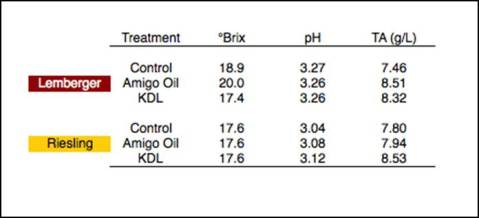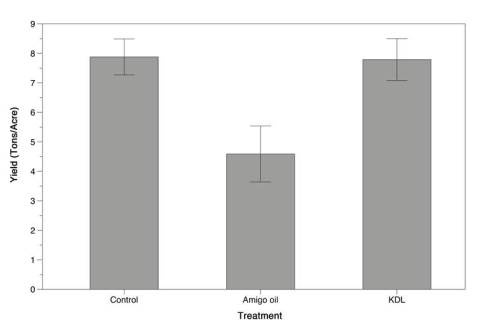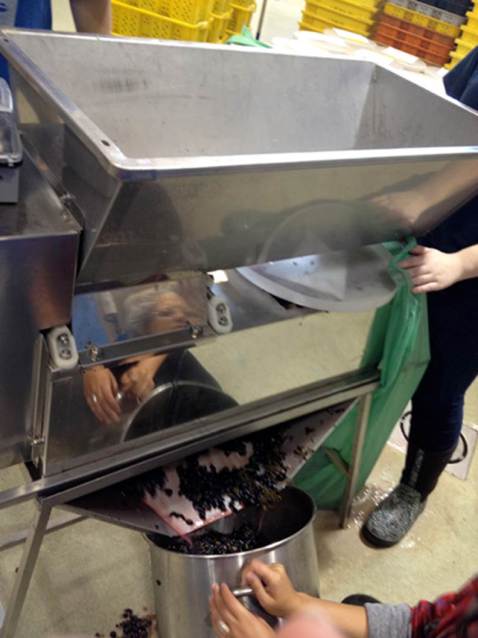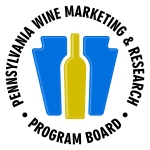Harvest 2014: An update to studies on frost injury
By: Maria Smith
Since I arrived in August, we have been busy at work continuing to collect field data on our current studies. In addition, we have been developing a new study which takes an in-depth look at the role of canopy management practices have on vine cold hardiness.
Harvest 2014:
After weeks of intense anticipation, monitoring berry development, and fretting over weather, harvest has finally come for us at the Centinari lab. As of last week, our commercial plots with Lemberger, Riesling, Noiret, and Traminette used to study frost tolerance and avoidance have all been harvested (Fig 1, See: “Evaluate cost-effective methods to decrease crop losses due to frost injury”). If you recall, these plots were sprayed with KDL, a commercially available cryo-protectant, and Amigo oil, a product used to delay bud break.
Our preliminary observations show that the Amigo oil treatments had noticeably lower yield in both Lemberger (Fig 2) and Riesling (data not shown) grapes harvested. Despite the lack of frost this spring, we did see a 2 week delay in bud break in Lemberger and a 1 week delay in Riesling with Amigo oil treatments. We are currently checking to see if these differences can be attributed to factors such as the number of shoots per vine between the treatments and/or cluster weight. However, if Amigo oil is in fact the cause of a decrease in yield we should see similar results over multiple years. In the case that Amigo oil has an actual affect on yield, it would be prudent to perform an economic analysis to decide if the use of Amigo oil as a frost avoidance mechanism is worth the cost in decreased yield.
Winemaking:
Winemaking is a crucial component in determining what sort of impacts delaying bud break can have on the final product. Thanks to the help of Denise Gardner and a group of students in a winemaking and enology independent study class, we have had the opportunity to crush, press, and ferment our harvested research grapes into wine (Fig 3).
In the initial juice, we have noticed an increase in Brix and TA between the Amigo oil and control treatments in Lemberger, though the Brix of all treatments in Riesling were similar (Table 1). We will be running additional detailed chemical analyses on frozen berry samples taken throughout ripening in the upcoming months.

Table 1. Juice analysis – Brix, pH, TA of Lemberger and Riesling. Riesling was chapitalized to 21 Brix.
Future work planned for analyzing the effects of Amigo Oil and KDL include:
- Grape Brix, TA, pH on samples from veraison through ripening
- Wine chemistry – Alcohol, SO2, and color density
- Sensory attributes of wine
- Prepare for year 2 KDL and Amigo Oil application
Winter 2014: New work on canopy management and cold hardiness:
We have recently begun work on a second study in cold hardiness. Canopy management practices are often used to improve the microclimate of grapes within the fruiting zone by exposing clusters to increased light and airflow. Early leaf removal (ELR) has been shown to successfully reduce cluster compactness in tight-clustering varieties, thus reducing incidents of bunch rot (Hed et al., 2014). Another common canopy management practice, cluster thinning (CT), is used to reduce fruit load of overcropping varieties to improve grape and wine quality. However, these practices may also change carbon source-sink relationships with cluster thinning removing carbon sinks and ELR removing photsynthetically active leaves (source), which could potentially alter cold acclimation and hardiness in the vine. Using ‘Chancellor’ vines under 3 imposed canopy management treatments – low-intensity leaf removal, high-intensity leaf removal, and CT – and an un-treated control at the Lake Erie Regional Grape Research and Extension Center, we plan to:
- Quantify non-structural starches and sugars associated with bud cold hardiness between Nov. 2014 and March 2015
- Assess how canopy management practices affect grape and wine chemistry and wine sensory perception
- Perform an economic analysis on the cost and return of canopy management practice implementation
Literature:
Head B, Ngugi HK, Travis JW (in press). Short- and long-term effects of leaf removal and gibberellin on Chardonnay grapes in the Lake Erie Region of Pennsylvania. American Journal of Enology and Viticulture. doi: 10.5344/ajev.2014.14034
The investigation of grapevine frost treatments is made possible by the John H. and Timothy R. Crouch Program Support Endowment, an endowment founded and funded by the Crouch brothers, original owners of Allegro Winery in Brogue, PA. Additional financial support is contributed by the Pennsylvania Wine Marketing & Research Board (PA WMRB). It is with great appreciation to investigate these projects based on funds and interest provided by the Pennsylvania wine community.
Acknowledgments:
A big thanks to Don Smith for his technical support in our lab and Denise Gardner for her assistance in winemaking. Also, thanks to our wine grape grower collaborators. _________________________________________________________________________________________________
Maria Smith is a viticulture PhD student with Michela Centinari, specializing in cold stress physiology of wine grapes.




